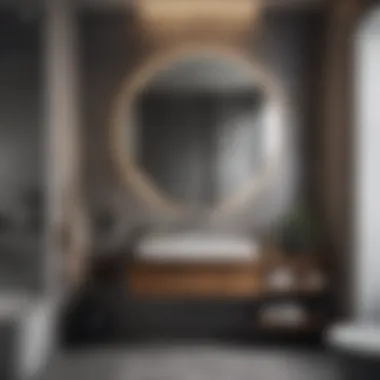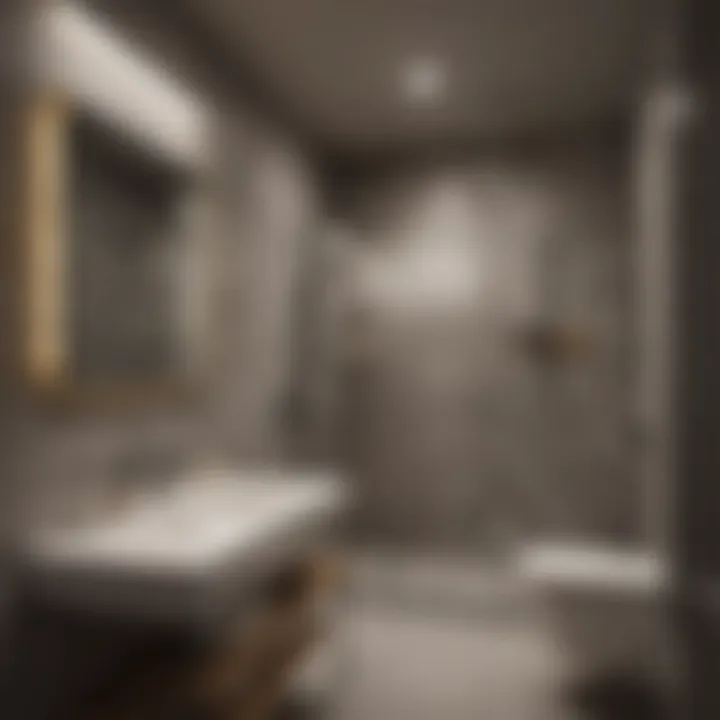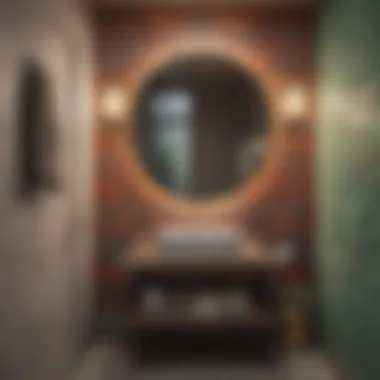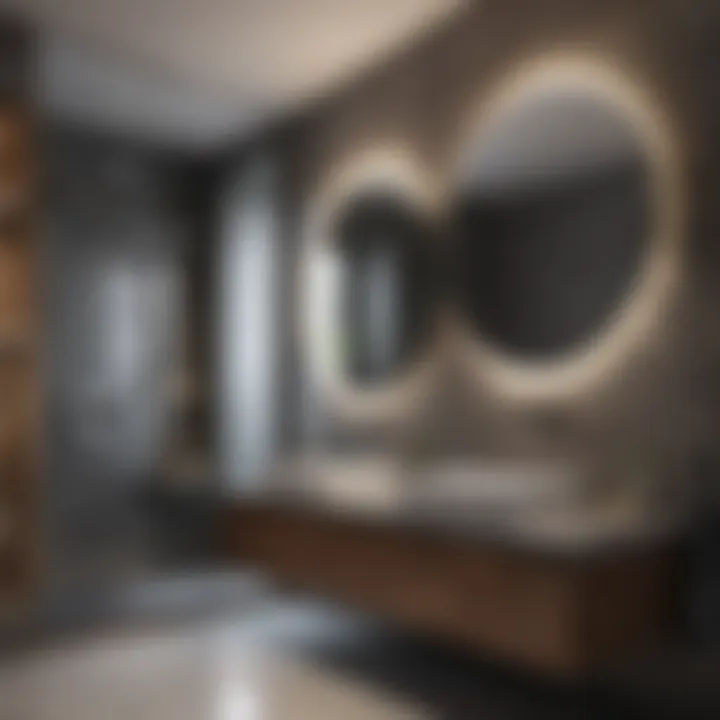Creative Solutions for Small Bathroom Design


Intro
Designing a small bathroom can present unique challenges, yet it also offers a fertile ground for creativity. Efficient use of space, minimizing clutter, and ensuring optimal functionality are paramount in this confined area. In this article, we will explore effective strategies that transform limited spaces into functional and aesthetically pleasing retreats. Our focus will be on innovative ideas that not only meet practical needs but also align with contemporary design trends.
Design Inspirations
When considering small bathroom design, visual inspiration can dramatically influence the final outcome. From chic minimalism to bold user-centric approaches, the designs one chooses can make a significant impact.
Trending Styles
Currently, several design styles are leading the charge in small bathrooms:
- Contemporary: Characterized by clean lines and modern materials, contemporary design emphasizes simplicity and uncluttered spaces.
- Scandinavian: Known for its functionality and minimalist approach, this style often incorporates natural light and muted color schemes, enhancing the spacious feeling.
- Industrial: With exposed fixtures and raw materials, an industrial aesthetic can add character. Choose metal accents and rugged surfaces.
- Vintage: Bringing a nostalgic touch, vintage elements can be integrated through accessories, tiles, and fixtures.
Color Palettes
Color plays an essential role in creating the illusion of space. Some popular palettes include:
- Light Neutrals: Whites, creams, and soft grays can brighten the room, making it feel more open.
- Cool Colors: Soft blues and greens can provide a sense of calm and spaciousness.
- Accent Variations: While light colors dominate, don’t shy away from bold accents. A single wall or accessories in deep colors can create a striking focal point without overwhelming the space.
Product Recommendations
Choosing the right products for a small bathroom can further enhance functionality and style. The following suggestions can help you maximize your design potential.
Bath Accessories
- Wall-mounted Shelves: These can free up floor space and create storage opportunities.
- Compact Vanity Units: Opt for narrower vanities that offer storage without taking up too much room.
- Mirrored Medicine Cabinets: They provide storage while reflecting light, helping to enlarge the perception of space.
Lighting Solutions
Good lighting is crucial in small bathrooms. Consider:
- Recessed Lighting: These fixtures can offer ambient light without occupying visual space.
- Sconces: Placed beside mirrors, sconces can create a luxurious feel while supplying focused light.
Takeaway: Design a small bathroom with thoughtfulness and creativity to improve both its function and style.
Ending
Understanding Small Bathroom Challenges
Understanding the challenges associated with small bathroom design is critical for homeowners looking to optimize their limited space. Small bathrooms can present unique hurdles, particularly regarding functionality and aesthetics. Every decision— from layout to fixture selection— plays a vital role in creating an efficient and appealing environment.
In a small bathroom, the limitations of space compel homeowners to innovate continually. Recognizing these limitations can lead to better design strategies that maximize both functionality and beauty. Furthermore, addressing these challenges allows individuals to transform cramped spaces into inviting retreats that cater to everyday needs while reflecting personal style.
Space Limitations and Design Implications
Space limitations in small bathrooms can significantly impact the design process. With constricted areas, every inch must be utilized effectively. This means that choices about layout, materials, and fixtures become even more crucial. A well-planned design can enhance the perception of space, making the area feel larger and more open.
Also, it's essential to consider the flow of movement within the bathroom. A design that facilitates easy access to essential elements, like the sink and shower, can contribute to the overall efficiency of the space. Compact fixtures, such as small vanities or wall-mounted toilets, can draw the eye upward and create an illusion of height, further expanding the perceived dimensions of the room.
Common Mistakes in Small Bathroom Design
Many homeowners unknowingly fall into traps when designing small bathrooms. One significant misstep is overcrowding the space with oversized fixtures or an abundance of decorative elements. This not only overwhelms the area but can also make it impractical for daily use. Select fixtures and accessories that provide functionality without compromising the space's openness.
Another frequent error involves neglecting storage solutions. In small bathrooms, clutter can build quickly, leading to a chaotic environment. To combat this, it's advisable to integrate smart storage solutions, such as recessed shelving or built-in cabinetry. These design choices not only maximize available space but also enhance the organization and visual appeal of the bathroom.
Additionally, avoiding dark color schemes can make a notable difference. Dark hues may occasionally provide a cozy feel, but they often constrict the sense of space. Opting for lighter color palettes can create an airy environment that feels larger and more welcoming.
In summary, awareness of the specific challenges encountered in small bathroom design is paramount. Addressing these issues with clear strategies will empower homeowners to make informed decisions and create beautiful, functional spaces.
Planning the Layout
The layout of a small bathroom is essential. A well-thought-out plan can increase both the visual appeal and functional performance of the space. Planning the layout involves assessing available space, choosing the right fixtures, and organizing zones based on functionality. Making informed choices at this stage can lead to a more pleasant experience for users.
Assessing Available Space
Before beginning any design venture, assessing available space is vital. This means taking precise measurements of the bathroom, including the height, width, and depth of each area. Understanding the dimensions helps determine what can realistically fit in the space without crowding it.
Consideration should also be given to crucial features like doors and windows, which can influence the placement of fixtures. For instance, a toilet placed too close to a door may restrict access, making the space less inviting. Notably, look for underutilized areas such as corners or niches where fixtures can be installed or where storage can be added.
Zoning for Functionality
Zoning is about designating specific areas for certain functions within the bathroom. Each zone should cater to its purpose while keeping the overall flow in mind.
- Sanitary Zone: This includes the toilet and any other plumbing fixtures. Keep enough space around each fixture for comfort and accessibility.
- Wash Zone: This area typically includes the sink and shower or bathtub. If space allows, try to provide separate areas for washing hands and showering to enhance convenience.
- Storage Zone: This part is often overlooked. Use vertical space for cabinets or shelves to keep necessary items within reach but out of sight.
Zoning can transform a small bathroom from a cramped area to a multifunctional space. With carefully defined zones, users can move fluidly and find what they need without hassle.


"A well-planned layout enhances the use of every inch in a small bathroom, turning it into a functional oasis."
Overall, planning the layout effectively addresses the unique challenges posed by small bathrooms. By thoroughly assessing the available space and adopting thoughtful zoning, homeowners can create a bathroom that is not just usable, but truly pleasant.
Color Schemes and Lighting
The selection of color schemes and lighting is paramount in small bathroom design. These elements do not merely influence aesthetics; they can significantly enhance or diminish the perceived space. Light colors tend to create an illusion of openness, while darker shades can make a compact area feel claustrophobic. Therefore, understanding how to skillfully choose and combine these aspects will lead to a more harmonious and spacious environment.
Choosing a Cohesive Color Palette
A cohesive color palette is the foundation for any successful small bathroom design. Opting for light, neutral tones can help maximize the feeling of space. Shades like soft whites, pastels, or light beige often work best. These colors reflect light, making the bathroom appear brighter and larger.
Consider also the emotional impact of colors. For instance, blue is calming, while yellow can evoke warmth. When selecting colors, ensure they complement each other effectively. One effective approach involves choosing a predominant color and then incorporating two or three complementary shades in accents like towels, rugs, or wall art.
"A well-chosen color palette in a small bathroom can do wonders for both space perception and mood enhancement."
Besides the main colors, think about finishes. Matte paints create a softer, more subtle effect, while glossy finishes can reflect light and add a modern touch. Combining these finishes can further enhance the visual interest without overwhelming the senses.
The Role of Natural and Artificial Lighting
Lighting can drastically alter the perception of a small bathroom. Natural light should be maximized where possible, as it not only expands the feel of the area but also showcases the chosen colors and textures effectively. If the bathroom has a window, consider installing lighter window treatments. Sheer fabrics allow light to filter in while providing some level of privacy.
In cases where natural light is limited, focusing on artificial lighting is crucial. Layering different light sources can create a well-lit and inviting atmosphere. Here are some points to consider:
- Task Lighting: Install focused lights near mirrors and over sinks to ensure adequate illumination for daily routines.
- Ambient Lighting: Use ceiling fixtures or wall sconces to provide general illumination. This reduces shadows and creates a welcoming environment.
- Accent Lighting: Adding LED strips under shelves or around vanity mirrors can highlight features and texture, contributing to depth.
Careful consideration of both natural and artificial lighting can transform a small bathroom from a basic space into a well-designed retreat.
Selecting Fixtures and Fittings
Choosing the right fixtures and fittings in a small bathroom is crucial for achieving a balance between style and practicality. These elements not only define the look and feel of the space but also play an essential role in functionality. In compact areas, every detail matters. Hence, the selection of fixtures must be deliberate and well-considered to maximize utility while maintaining an aesthetic appeal.
When selecting fixtures, consider elements such as size, shape, and functionality. Opting for space-efficient designs can free up crucial floor area, making the bathroom feel larger than its actual dimensions. Moreover, the right fixtures can enhance overall convenience, streamlining daily routines and ensuring a seamless user experience.
Here are key considerations when selecting fixtures:
- Proportions: Choose fixtures that fit comfortably in the designated area without overwhelming it.
- Style: Ensure that fixtures complement the overall design theme of the bathroom. Unifying colors and designs can create a coherent look.
- Functionality: Every fixture should provide value, whether through enhanced storage options or increased accessibility.
Small changes in fixture design can lead to meaningful impacts in both space utilization and aesthetics.
Compact and Functional Fixtures
Compact fixtures are invaluable in small bathrooms. They minimize the amount of space taken up while maintaining functionality. Wall-mounted sinks and toilets, for instance, can lend an illusion of more space, as they free up floor area. Additionally, vessel sinks or even corner sinks can maximize the available countertop.
Furthermore, replacing traditional bathtubs with showers can transform the layout effectively. Consider shower units with clear glass enclosures, which preserve visual openness. Sliding doors can also save space compared to swinging ones.
Other compact fixtures that add substantial value include:
- Foldable or retractable shower benches: These provide comfort without compromising space.
- Narrow vanities: They offer necessary storage while fitting snugly into limited areas.
- Compact faucets: Single-handle faucets typically offer better usability in smaller spaces.
Innovative Storage Solutions
Effective storage is essential in small bathrooms, where clutter can quickly accumulate. Innovative storage solutions prevent chaos while keeping essentials within reach. consider utilizing vertical space by adding shelves above toilets or utilizing tall cabinets that extend upward.
Another great idea is to use multi-functional furniture. Some mirrors come with built-in shelves, combining two needs into one efficient fixture. Under-sink cabinets also provide hidden storage and should be properly tailored to fit the available area.
Here are some innovative storage ideas:
- Magnetic strips for small metallic items: These can be affixed inside cabinets to store tweezers or small scissors.
- Baskets and decorative boxes: These can hide smaller items stylishly while fitting in tight corners.
- Pull-out drawers: Underneath vanities, these can maximize space and accessibility.
When planned right, storage solutions not only alleviate clutter but also enhance the overall aesthetic appeal of the small bathroom.
Materials and Textures
Materials and textures play a crucial role in small bathroom design. The right choices can significantly enhance both the aesthetic appeal and functionality of the space. When selecting materials, it is important to consider durability, water resistance, and maintenance. Small bathrooms often experience high levels of moisture, so using materials that can withstand this environment is essential.
Additionally, the selection of textures can influence how a space feels. A balance between smooth and rough textures can help create visual interest and depth. This can be particularly important in compact areas, where every design element must contribute to a cohesive look. Working with materials and textures wisely allows for a more open feel, promoting a sense of tranquility and organization.
Practical and Aesthetic Material Choices
When designing a small bathroom, practical and aesthetic material choices are essential. Popular options include porcelain tiles, which are both water-resistant and available in various styles, mimicking the look of natural stones like marble or wood. Another good choice is quartz countertops, which offer durability without sacrificing elegance.
Additionally, consider using opaque glass for shower enclosures. This not only prevents water splashes but also enhances the illusion of space. Some homeowners opt for lighter-colored materials to reflect more light and create an airy atmosphere.
Uniquely patterned tiles or textured wall panels can also act as statement pieces in a small bathroom without overwhelming the space. Here are some key elements to think about when selecting materials:
- Durability: Choose materials that can withstand water and humidity.
- Maintenance: Consider how easy it is to clean and maintain the materials.
- Costs: Set a budget for materials early in the design process.
- Aesthetic appeal: Pick textures and colors that align with your style preferences.
Incorporating Textures Wisely


Incorporating textures wisely can transform a small bathroom from ordinary to extraordinary. Start by layering different textures to achieve a rich visual effect. For example, consider mixing smooth surfaces, like glossy tiles or a sleek vanity, with rough elements such as textured wallboards or woven baskets for storage.
It is critical to choose textures that complement each other. Too many competing textures can make a small space feel cluttered. Instead, aim for harmony. A good approach is to limit the number of dominant textures to two or three.
Another important aspect is the placement of textures. For instance, placing textured tiles along the floor can direct the eye upward, creating an effect of height. Similarly, incorporating a textured backsplash is a subtle method to invite depth without overtaking the visual landscape of the bathroom.
"The balance of textures can elevate the overall aesthetic without compromising the functionality required in small bathrooms."
Overall, the selection and application of materials and textures are fundamental to achieving an ideal small bathroom design. The goal is to create an inviting, functional space that reflects personal style while meeting practical needs.
Utilizing Vertical Space
In small bathrooms, every square foot counts. Utilizing vertical space becomes crucial to enhance both functionality and aesthetics. By considering how to effectively use walls, homeowners can create an illusion of space while also maximizing storage. Reaching upwards can free floor areas, presenting a more open and inviting environment. This approach is particularly significant in confined spaces where traditional layouts might falter.
The advantages of focusing on vertical aspects in bathroom design include increased storage, improved organization, and the opportunity to introduce style. Investing in wall-mounted elements or tall cabinets can enhance the room’s usability without sacrificing its appeal. It allows for the incorporation of personal touches through decorations and accessories, creating a space that feels cohesive and well-thought-out.
Several considerations arise when implementing vertical storage solutions. Balance is important. Too much emphasis on height may lead to overwhelming visuals or a cluttered feeling. Therefore, selecting the appropriate height and arrangement of fixtures is vital. Utilizing neutral colors can also help in making the space feel larger. Ultimately, the goal is to create a functional yet stylish environment.
Wall-Mounted Solutions
Wall-mounted solutions are a game changer in small bathroom design. They help to keep floors clear while providing necessary functionality. For instance, wall-mounted sinks or toilets can save valuable floor space. This not only makes cleaning much easier but also offers a sleek, modern appearance that can elevate the design.
There are a variety of wall-mounted installations available, including:
- Vanities: Freestanding options often take up more space, while wall-mounted vanities can free up much-needed room.
- Toilets: Installing a wall-hung toilet can create a clean, contemporary look and simplify maintenance.
- Shelves: Floating shelves can be an excellent way to display toiletries or decorations without the bulk of traditional furniture.
It’s essential to ensure that wall-mounted items are securely installed, considering plumbing and weight capacity to avoid future issues. The use of these solutions not only aids in maximizing floor space but creates a seamless design flow.
Shelving and Cabinets
Shelving and cabinets designed for vertical use can significantly impact a small bathroom’s layout. These elements serve dual purposes of storage and aesthetics. High cabinets or built-in shelving can store linens, toiletries, or cleaning supplies while maintaining visual appeal. They also provide a sense of organization, reducing clutter on countertops.
In terms of design, consider the following:
- Customized Shelving: Tailoring shelves to fit specific dimensions ensures maximum utility without compromising style.
- Open vs. Closed Storage: Open shelves can create an airy feeling, but closed cabinets help reduce visible mess. Choose what best meets your needs.
- Color and Material Choices: Lighter materials or colors can enhance the sense of space, while darker hues can add drama and warmth. Each choice reflects personal style and functionality.
Incorporating vertical storage solutions creatively can drastically improve functionality without compromising the design of small bathrooms.
In summary, using vertical space effectively transforms a small bathroom's design. Wall-mounted solutions and appropriately designed shelving units introduce practicality while reflecting personal style. The right balance between function and elegance can convert a confined area into a delightful retreat.
Incorporating Technology
In the contemporary era, incorporating technology into small bathroom design elevates both functionality and efficiency. Homeowners increasingly seek ways to improve their daily routines, and technology provides practical solutions that can maximize the limited space in a small bathroom.
Smart Solutions for Small Spaces
Smart solutions have become essential in optimizing small bathrooms. Devices like smart mirrors with integrated lighting and Bluetooth capabilities streamline the daily grooming routines. These mirrors not only provide excellent illumination but also allow for connectivity with smartphones, enabling users to listen to music or answer calls hands-free.
Another significant innovation is the installation of smart toilets. These fixtures offer numerous features such as automatic flushing, heated seats, and built-in bidets. These enhancements not only improve hygiene but also occupy a smaller footprint compared to traditional toilets, making them ideal for compact settings.
Moreover, smart showers equipped with digital controls allow users to set personalized temperature and water pressure settings, enhancing comfort and control. This level of meticulous personalization ultimately contributes to a more pleasant bathing experience. Incorporating these technologies requires some upfront investment; however, the long-term benefits can be substantial.
By integrating smart solutions, homeowners can transform their small bathrooms into highly functional and user-friendly spaces.
Energy-Efficient Options
Energy efficiency is a crucial consideration when designing small bathrooms. Modern technology offers several energy-efficient options that not only reduce utility costs but also minimize environmental impact.
For lighting, LED fixtures are a preferred choice. They consume significantly less energy compared to traditional incandescent bulbs. In addition, smart lighting systems enable users to control brightness levels and set schedules, ensuring lights are only on when needed. This leads to substantial energy conservation.
Water efficiency is another major focus. Low-flow faucets, showerheads, and toilets are designed to use less water without compromising performance. By investing in these fixtures, homeowners can effectively reduce water waste while maintaining adequate flow rates.
Lastly, consider heated floors or towel warmers that utilize energy-efficient technologies. These options provide warmth and comfort in small spaces, particularly during the colder months, while being mindful of energy consumption.
Incorporating these energy-efficient elements creates a bathroom that is not only stylish but also environmentally friendly.
Designing for Accessibility
Designing for accessibility in small bathrooms is crucial for creating spaces that accommodate diverse needs. With a growing awareness of inclusivity in design, this approach ensures that bathrooms are not only functional but also user-friendly for individuals of all ages and abilities. Accessibility considerations can enhance comfort and safety, promoting an environment that fosters independence.
Universal Design Principles
Universal design principles aim to create spaces that are usable by as many people as possible, regardless of their physical abilities. Key elements of universal design in bathrooms include:
- Lever Handles: Opt for lever-style faucet handles and door levers, which are easier to operate for people with limited hand strength.
- Non-Slip Floors: Using non-slip materials for flooring reduces the risk of slips and falls, making the space safer.
- Grab Bars: Install grab bars near the toilet and shower areas to provide support and stability.
- Adjustable Fixtures: Consider adjustable showerheads and faucets to accommodate different user heights and needs.
- Wide Doorways: Ensure doorways are wide enough to allow for wheelchair access, generally a minimum of 32 inches.
Implementing these features creates an environment that is not just functional but also welcoming.
Considerations for Mobility Limitations


For individuals with mobility limitations, careful planning and design can vastly improve their bathroom experience. Some vital considerations include:
- Choosing Space-Efficient Fixtures: Select wall-mounted toilets and sinks that optimize floor space while allowing easier access.
- Turning Radius: Allow sufficient turning radius within the bathroom for wheelchairs or walkers. Aim for at least a 60-inch diameter circle for maneuverability.
- Seat Height for Toilets: Install higher toilets to ease transition from standing to sitting, which can be especially helpful for those with knee or hip issues.
- Seamless Shower Entry: Design a walk-in shower with no threshold to eliminate tripping hazards, making it easier for individuals with mobility aids.
"Accessibility is not a feature; it is a requirement for a truly functional space."
Incorporating these elements not only meets functional needs but also reflects a commitment to inclusivity in design. By prioritizing accessibility, homeowners can create bathrooms that serve everyone effectively, fostering dignity and independence for users.
Trends in Small Bathroom Design
Understanding the current trends in small bathroom design is crucial for anyone looking to optimize their limited space. These trends not only enhance the aesthetic appeal of a bathroom but also improve its functionality. Being aware of these trends helps homeowners to make informed decisions about renovation or design choices. It allows for the incorporation of modern elements that align with current tastes and also promote greater utility.
Current Aesthetic Trends
Aesthetic trends in small bathroom design have shifted significantly over recent years. One prominent trend is the use of minimalism. This approach advocates for fewer, well-chosen items that are functional and stylish. Colors tend to skew towards soft, neutral palettes, often accented with darker tones to add depth.
Key aspects of current aesthetic trends include:
- Natural Materials: There is a growing preference for natural materials like wood and stone. These materials offer warmth and can create a cozy atmosphere in compact areas.
- Open Shelving: This provides both practicality and a way to display decorative items. Open shelves can make a bathroom feel less cramped while also housing essential items within reach.
- Smart Storage Solutions: Concealed storage behind mirrors or within customizable cabinetry helps maintain a clean and uncluttered visual.
Incorporating these elements not only improves the visual appeal but also enhances the overall user experience.
Sustainable Design Practices
Sustainability is another important aspect of modern bathroom design. Increasing awareness of environmental impact is influencing many homeowners to consider eco-friendly options. Sustainable design practices in small bathrooms contribute to energy efficiency and reduce waste, thus benefiting both users and the planet.
Important sustainable practices to consider include:
- Water-Efficient Fixtures: Installing low-flow toilets and faucets can significantly decrease water usage, which has both environmental and cost benefits.
- Energy-Saving Lighting: LED lighting is a prime example of an energy-efficient alternative that brightens a space without excessive energy consumption.
- Recycled Materials: Utilizing recycled tiles or countertops can add a unique character and contribute towards sustainability goals.
"Adopting sustainable practices in small bathroom design is not just beneficial for the environment, but it also enhances the quality of living."
All these practices reflect a deeper commitment to sustainability in modern design philosophies. Homeowners can create a stylish bathroom that also aligns with their values, ensuring that their choices are as conscientious as they are aesthetic.
Final Touches
In the realm of small bathroom design, the final touches play a crucial role in enhancing both functionality and aesthetic appeal. Often, it is the small details that transform a simple space into a stylish and inviting sanctuary. Adding the right accessories, choosing appropriate textiles, and integrating elements that reflect personal taste can make a significant difference in how the space is perceived and experienced. These finishing elements are not just about beauty; they also contribute to the overall usability of the bathroom.
A well-thought-out approach to final touches ensures that the design remains cohesive and tailored to the homeowner's lifestyle. This section will explore how to select accessories with purpose and how to create a harmonious look with textiles.
Choosing Accessories with Purpose
Choosing bathroom accessories with intention is essential in a small space. Every element should not only serve a function but also enhance the overall design. Consider items such as towels, soap dispensers, or decorative trays. Each piece should reflect a coherent style. For example, sleek metal accessories can give a modern look, while bamboo accents may evoke a more natural feel.
Here are some factors to consider when selecting accessories:
- Functionality: Prioritize accessories that provide utility. For instance, choose hooks or racks that save space and keep the area organized.
- Material Selection: Consider materials that are durable and easy to clean, as bathrooms tend to experience moisture and wear.
- Color Coordination: Accessories should align with the color palette of the room. Ensure that they either complement or contrast effectively without causing chaos in visuals.
- Personal Touch: Select items that express individual style, such as framed pictures, scented candles, or plants, which can breathe life into the space.
"Small bathroom accessories should marry form and function, as they shape both utility and aesthetics."
Each accessory contributes to making the space feel more complete. When carefully chosen, these items elevate the design and ensure the area remains practical.
Creating a Cohesive Look with Textiles
Textiles can dramatically impact the ambiance of a small bathroom. When chosen wisely, they can add warmth and texture, making the space feel less cramped and more inviting. It is important to create a cohesive look by selecting textiles that harmonize with the overall design theme.
Key considerations include:
- Towel Selection: Opt for towels that coordinate with the wall colors or accessories. The choice of pattern or solid color can affect visual momentum in the space.
- Shower Curtains: A well-chosen shower curtain can serve as a focal point. It should not only match textile colors but also the bathroom's overall theme.
- Rugs and Mats: To soften the flooring, select mats that correspond to the color scheme and design style, while also providing comfort underfoot.
- Layering Textiles: Mixing textures, such as adding a knitted basket to hold towels alongside smooth fabrics, can create depth and interest in the décor.
Implementing these textile strategies leads to a well-rounded aesthetic. A cohesive look can enhance the overall harmony of the bathroom, making it both pleasant and practical for daily use.
Case Studies and Examples
Exploring real-life examples of small bathroom designs offers valuable insights into effective strategies and innovative solutions. Case studies provide a practical perspective, illustrating how design concepts translate into usable spaces. Readers can understand the impact of various choices—from layout and materials to fixtures and color schemes. This section aims to showcase practical transformations, enabling homeowners and designers to envision what is possible within their limited spaces.
Successful Small Bathroom Transformations
Successful transformations demonstrate how creative thinking and smart planning can turn small bathrooms into functional and appealing areas. Each example serves as a blueprint, showing how certain elements can maximize utility while ensuring style is not sacrificed.
- Case 1: Urban Apartment Revamp
In a compact city apartment, an outdated bathroom was redesigned by incorporating sleek, wall-mounted cabinets that enhanced storage without taking much floor space. Using a light color palette, the room felt airy and spacious. The addition of a large mirror helped reflect light, contributing to an open feel. - Case 2: Family Home Refresh
A suburban family's bathroom was remodeled by introducing a corner shower unit in place of a bulky bathtub. By selecting clear glass walls for the shower, visual clutter was reduced. This change created a more open environment, making the space appear larger without compromising functionality. - Case 3: Modern Minimalist Approach
A minimalist design was employed in a studio apartment. The designer used a simple floating vanity with integrated storage, keeping surfaces clear. The use of bold accents, like black fixtures against a white backdrop, added an element of interest while maintaining simplicity.
These examples illustrate that with thoughtful design and selection, small bathrooms can achieve significant functionality and style.
Lessons Learned from Design Challenges
Designing small bathrooms often presents unique challenges. However, these experiences can offer critical lessons for future projects. Understanding what works and what doesn’t can guide homeowners towards making informed decisions in their own designs.
- Space Management
A common issue in small bathrooms is overcrowding. Yet, designers have learned to avoid bulky fixtures and heavy materials. This demonstrates the importance of selecting compact, multifunctional elements that save space. - Lighting Considerations
Poor lighting can diminish the appearance of a small bathroom. Case studies highlight the effective use of natural and artificial light. Many successful transformations utilized layered lighting techniques to create depth and warmth, which proved essential in elevating the overall ambiance.
"Effective lighting transforms small spaces from drab to drams."
- Personalization
Ultimately, homeowners should not shy away from personal touches. Successful designs often include unique decor items or meaningful artwork that reflect the occupant’s personality. Balancing practicality with individuality can create a welcoming atmosphere.
In summary, the exploration of case studies provides both inspiration and guidance. By examining successful transformations and learning from design hurdles, readers can take actionable steps towards optimizing their own small bathroom spaces.



